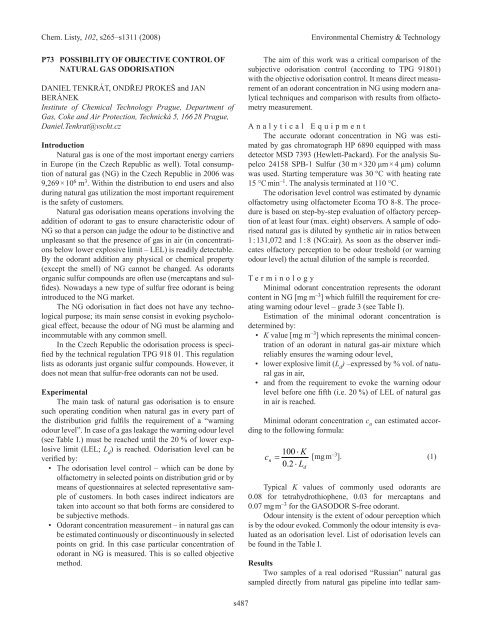2. ENVIRONMENTAL ChEMISTRy & TEChNOLOGy 2.1. Lectures
2. ENVIRONMENTAL ChEMISTRy & TEChNOLOGy 2.1. Lectures
2. ENVIRONMENTAL ChEMISTRy & TEChNOLOGy 2.1. Lectures
Create successful ePaper yourself
Turn your PDF publications into a flip-book with our unique Google optimized e-Paper software.
Chem. Listy, 102, s265–s1311 (2008) Environmental Chemistry & Technology<br />
P73 POSSIbILITy OF ObjECTIVE CONTROL OF<br />
NATuRAL GAS ODORISATION<br />
DAnIEL TEnKRáT, OnDřEJ PROKEŠ and JAn<br />
BERánEK<br />
Institute of Chemical Technology Prague, Department of<br />
Gas, Coke and Air Protection, Technická 5, 166 28 Prague,<br />
Daniel.Tenkrat@vscht.cz<br />
Introduction<br />
natural gas is one of the most important energy carriers<br />
in Europe (in the Czech Republic as well). Total consumption<br />
of natural gas (nG) in the Czech Republic in 2006 was<br />
9,269 × 10 6 m 3 . Within the distribution to end users and also<br />
during natural gas utilization the most important requirement<br />
is the safety of customers.<br />
natural gas odorisation means operations involving the<br />
addition of odorant to gas to ensure characteristic odour of<br />
nG so that a person can judge the odour to be distinctive and<br />
unpleasant so that the presence of gas in air (in concentrations<br />
below lower explosive limit – LEL) is readily detectable.<br />
By the odorant addition any physical or chemical property<br />
(except the smell) of nG cannot be changed. As odorants<br />
organic sulfur compounds are often use (mercaptans and sulfides).<br />
nowadays a new type of sulfur free odorant is being<br />
introduced to the nG market.<br />
The nG odorisation in fact does not have any technological<br />
purpose; its main sense consist in evoking psychological<br />
effect, because the odour of nG must be alarming and<br />
incommutable with any common smell.<br />
In the Czech Republic the odorisation process is specified<br />
by the technical regulation TPG 918 01. This regulation<br />
lists as odorants just organic sulfur compounds. However, it<br />
does not mean that sulfur-free odorants can not be used.<br />
Experimental<br />
The main task of natural gas odorisation is to ensure<br />
such operating condition when natural gas in every part of<br />
the distribution grid fulfils the requirement of a “warning<br />
odour level”. In case of a gas leakage the warning odour level<br />
(see Table I.) must be reached until the 20 % of lower explosive<br />
limit (LEL; Ld ) is reached. Odorisation level can be<br />
verified by:<br />
• The odorisation level control – which can be done by<br />
olfactometry in selected points on distribution grid or by<br />
means of questionnaires at selected representative sample<br />
of customers. In both cases indirect indicators are<br />
taken into account so that both forms are considered to<br />
be subjective methods.<br />
• Odorant concentration measurement – in natural gas can<br />
be estimated continuously or discontinuously in selected<br />
points on grid. In this case particular concentration of<br />
odorant in nG is measured. This is so called objective<br />
method.<br />
s487<br />
The aim of this work was a critical comparison of the<br />
subjective odorisation control (according to TPG 91801)<br />
with the objective odorisation control. It means direct measurement<br />
of an odorant concentration in nG using modern analytical<br />
techniques and comparison with results from olfactometry<br />
measurement.<br />
A n a l y t i c a l E q u i p m e n t<br />
The accurate odorant concentration in nG was estimated<br />
by gas chromatograph HP 6890 equipped with mass<br />
detector MSD 7393 (Hewlett-Packard). For the analysis Supelco<br />
24158 SPB-1 Sulfur (30 m × 320 μm × 4 μm) column<br />
was used. Starting temperature was 30 °C with heating rate<br />
15 °C min –1 . The analysis terminated at 110 °C.<br />
The odorisation level control was estimated by dynamic<br />
olfactometry using olfactometer Ecoma TO 8-8. The procedure<br />
is based on step-by-step evaluation of olfactory perception<br />
of at least four (max. eight) observers. A sample of odorised<br />
natural gas is diluted by synthetic air in ratios between<br />
1 : 131,072 and 1 : 8 (nG:air). As soon as the observer indicates<br />
olfactory perception to be odour treshold (or warning<br />
odour level) the actual dilution of the sample is recorded.<br />
T e r m i n o l o g y<br />
Minimal odorant concentration represents the odorant<br />
content in nG [mg m –3 ] which fulfill the requirement for creating<br />
warning odour level – grade 3 (see Table I).<br />
Estimation of the minimal odorant concentration is<br />
determined by:<br />
K value [mg m –3 •<br />
] which represents the minimal concentration<br />
of an odorant in natural gas-air mixture which<br />
reliably ensures the warning odour level,<br />
• lower explosive limit (Ld ) –expressed by % vol. of natural<br />
gas in air,<br />
•<br />
and from the requirement to evoke the warning odour<br />
level before one fifth (i.e. 20 %) of LEL of natural gas<br />
in air is reached.<br />
Minimal odorant concentration c n can estimated according<br />
to the following formula:<br />
c<br />
n<br />
100 ⋅ K<br />
= [mg m<br />
0.<br />
2 ⋅ L<br />
–3 ]. (1)<br />
d<br />
Typical K values of commonly used odorants are<br />
0.08 for tetrahydrothiophene, 0.03 for mercaptans and<br />
0.07 mg m –3 for the GASODOR S-free odorant.<br />
Odour intensity is the extent of odour perception which<br />
is by the odour evoked. Commonly the odour intensity is evaluated<br />
as an odorisation level. List of odorisation levels can<br />
be found in the Table I.<br />
Results<br />
Two samples of a real odorised “Russian” natural gas<br />
sampled directly from natural gas pipeline into tedlar sam-

















